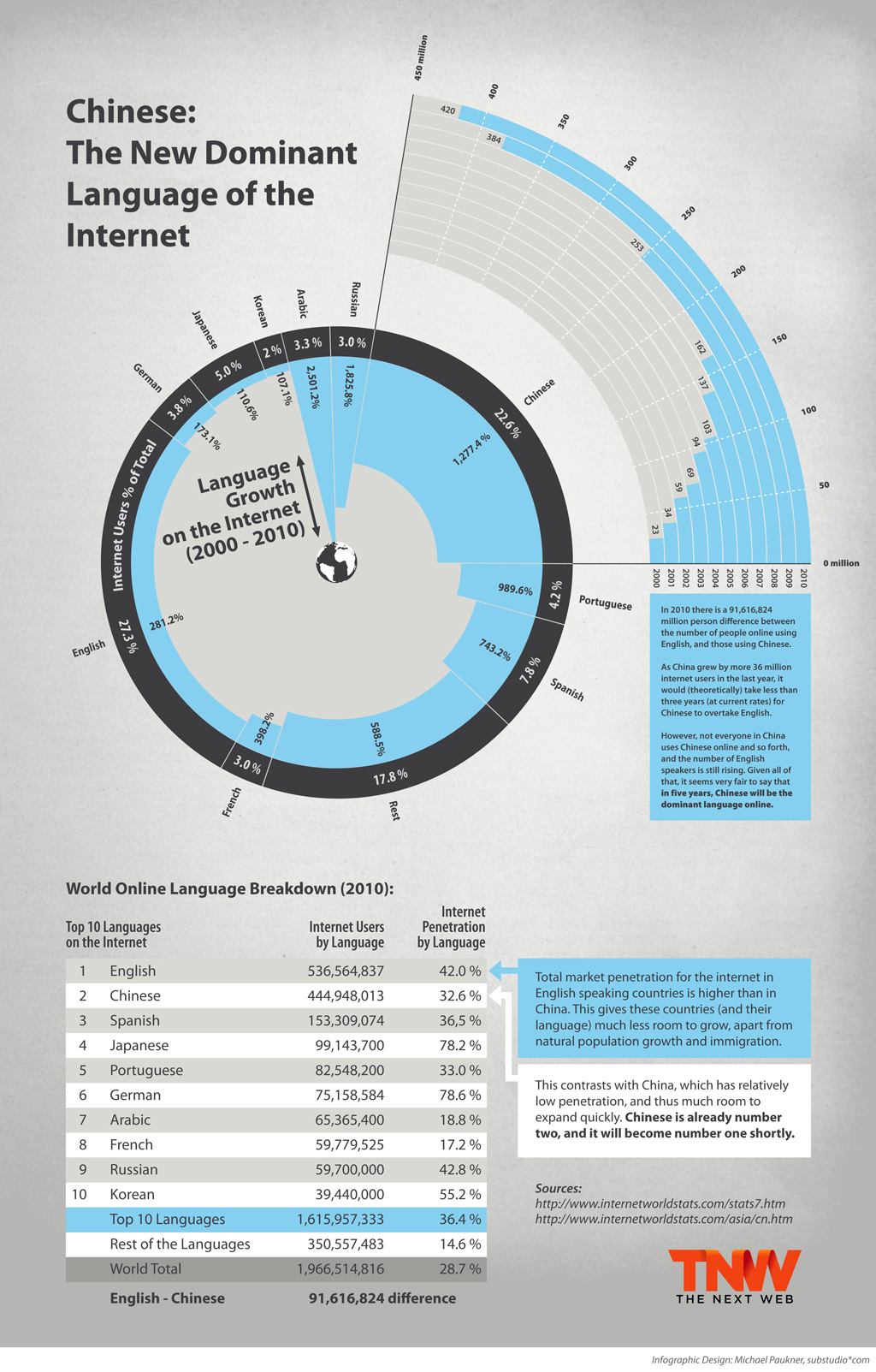
LITTLE PIM BLOG
Chinese: The New Dominant Language of the Internet
Did you know that Chinese is on track to become the most-used language on the internet? According to Internet World Stats, there were 649,375,491 Chinese-speaking internet users in December 2013, making it second to only English, the most frequently-used language on the internet.
But experts predict English's dominance won't last long. Based on its fast pace of growth, within the next few years Chinese is expected to overtake English as the top language of the internet.
Check out the infographic below from The Next Web that shows the fast pace of Chinese language use on the internet, as well as the statistics for the top 10 languages of the world.
Want your child to start learning the soon-to-be dominant language of the internet? Check out our Chinese language learning program for kids.
And guess what? Each of the top 10 languages on the internet is available on Little Pim (or will be soon in the case of Korean).
With other languages starting to outpace English, it's important to prepare for the future. They can start learning today with our award-winning program.
10 Great Kids Books With Global Appeal
 Sail away with your kids to magical lands across the sea – just by picking up a book. These 10 great kids books will give your family a glimpse of cultures and a taste of languages around the world. You can read all of them in English, but if you’re feeling up to it, several (such as the French classic The Little Prince) can easily be found in their original language. Whatever you choose, reading with your kids is a great way to bond and let their imaginations grow. Plus, it’s one step closer to getting ready for school, which will be here before you know it.
Sail away with your kids to magical lands across the sea – just by picking up a book. These 10 great kids books will give your family a glimpse of cultures and a taste of languages around the world. You can read all of them in English, but if you’re feeling up to it, several (such as the French classic The Little Prince) can easily be found in their original language. Whatever you choose, reading with your kids is a great way to bond and let their imaginations grow. Plus, it’s one step closer to getting ready for school, which will be here before you know it.
Europe
1. The Adventures of TinTin (Belgium) – A dog and his intrepid young reporter owner solve mysteries around the world – the comic strip imagery is especially popular with young children; and the comics are also available in French.
2. The Little Prince – A lovely French classic that tells the story of an aviator who meets a prince from a distant asteroid while stranded in the desert. This is a good one to try in French if you can.
3. The Invention of Hugo Cabret – Take a trip through Paris with the vivid pencil images in this imaginative story of Hugo, a boy who lives in a train station in Paris, and the friend who helps uncover his mechanical secret.
4. Strega Nona—Although written in English, this is the tale of an Italian “Grandma Witch” who lives in Calabria and makes enough pasta to bury an entire town. There are more than a dozen Strega Nona stories to keep the pasta-fueled fun going.
Scandinavia
 5. Pippi Longstocking –Sweden’s contribution to global kids’ imaginations is this firecracker of a main character, a red-headed 9-yr-old with a with a suitcase full of gold, a pet monkey, and horse on her front porch. A great read out loud book that will make you and your kids laugh out loud.
5. Pippi Longstocking –Sweden’s contribution to global kids’ imaginations is this firecracker of a main character, a red-headed 9-yr-old with a with a suitcase full of gold, a pet monkey, and horse on her front porch. A great read out loud book that will make you and your kids laugh out loud.
6. The Moomins – A Swedish/Finnish illustrated collection of books about a family of animal-like creatures. The pictures are sure to captivate kids, and if they really love it, there’s even a Moomin theme park in Finland!
Asia
 7. Lon Po Po – A Red Riding Hood Story from China – In this Chinese reworking of the classic Grimm fairytale, three sisters in rural China outwit the (heads up, relatively scary looking) Lon Po Po (Granny Wolf). Great for kids who like their stories to keep them on the edge of their seat.
7. Lon Po Po – A Red Riding Hood Story from China – In this Chinese reworking of the classic Grimm fairytale, three sisters in rural China outwit the (heads up, relatively scary looking) Lon Po Po (Granny Wolf). Great for kids who like their stories to keep them on the edge of their seat.
8. The REAL Story of Stone Soup – Another children’s classic story with a Chinese twist. This time three clever brothers turn stones into egg drop soup – keep an eye out for Chinese vocabulary sprinkled throughout the story.
Africa
 9. Anansi The Spider – From West Africa comes this Ashanti fable of a small spider who must make a big decision.
9. Anansi The Spider – From West Africa comes this Ashanti fable of a small spider who must make a big decision.
10. We All Went on Safari -- A counting journey through a safari in Tanzania. There’s a surprising amount of rhythmic Swahili vocabulary tucked into the illustrations of animals.
A Family Friendly Chinese New Year Celebration
 Streamers? Check. Noise makers? Check.
Streamers? Check. Noise makers? Check.
Don’t put away your New Year’s decorations just yet -- January 31 marks the start of the Chinese New Year and it’s a great excuse to have a fun-filled celebration with your family.
This year is the Year of the Horse and will be celebrated with parties, food, dragon dances, and fireworks both in China and in Chinatown’s throughout North America.
Chinese New Year is also called the Lunar New Year because it’s celebrated on the first day of the first month of the lunar calendar – and this year’s celebration will ring in the year 4712.
Want to celebrate the Year of the Horse? Here are 4 easy ways to join in the fun.
1. Learn a bit of Chinese:
Kung Hey Fat Choy! Means “Happy New Year!” and is the standard greeting throughout the holiday.
2. Dress the part:
Don whatever red clothing you have --- red is a lucky color in Chinese culture.
3. Decorate for your celebration:
Paper lanterns are a perfect project for craft time with your kids (although they can be any color, consider red to keep the new year’s theme).
4. Wok up a family-friendly Chinese dish:
The Lunar New Year is a usually celebrated with a big family meal.
Fried Rice is a great option to make at home with your family – let your children add their favorite veggies and practice picking up larger pieces of veggies with chopsticks while you cook.
CHINESE NEW YEAR FRIED RICE
(The vegetables below are just a guideline, feel free to substitute or add your favorites)
Heat 2 tablespoons of vegetable oil in a wok or large skillet.
Add 1 chopped onion and 2 small cloves of chopped garlic. Cook until soft, 2 to 3 minutes.
Add approximately 1 cup of chopped pepper, carrots, celery or sliced snow peas. Cook until tender, about 5 minutes.
Mix in 2 cups of cooked rice and stir until vegetables are fully mixed in.
Create an open hole in the middle of your pan and add 1 tsp of oil, then add 2 beaten eggs. Scramble eggs in hole, then mix into rice mixture.
Finally, add 3 to 4 tablespoons of soy sauce and stir through rice mixture until full seasoned.
Here's one more Chinese phrase you'll want to know when you're done eating:
Nn, mìan hăo chī! 嗯,面 好 吃! Mm! It’s good!!
The Holiday Ebook Is Here!
Yup, that's our holiday ebook in the Kindle store! It's hard to believe that a little over 2 months ago, Around the World with Little Pim was basically just an idea. We launched our Kickstarter campaign with crossed fingers, and now here we are: fully funded with our holiday ebook on Amazon just in time for the holidays.
But enough reminiscing...
The Little Pim holiday ebook is finally a reality and we really hope you enjoy it. We have sent Little Pim to France, Mexico, Brazil, and China to sample some tasty holiday treats and learn about how other countries and cultures celebrate the winter holidays. Join him on this delicious adventure and you might just pick up a few new words in French, Spanish, Portuguese, and Chinese!
If you could go on a holiday food tour like Little Pim, where would you go?
The Little Pim Kickstarter is Live!
Aaaand we're live! We've only got 30 days to make our goal, so let's make 'em count. We can't do this without your amazing support so click below to learn a little more about the Little Pim ebook Kickstarter, make your pledge, and share with your friends!
What Is Kickstarter?
- It’s a website where anyone can pitch a creative project. So we’re pitching our ebook!
- If you think it’s a good idea, you can back the project. Donations of ALL sizes are welcome
- If you back a project with a donation, you get a reward! Our rewards, which would make great holiday gifts, include pre-orders of the ebook, getting your child drawn in as a character, and lots of other surprises in between…
- If we reach our goal, we get the funds we need to make the ebook and you get your rewards!
- If we don’t make our goal, we get nothing and you don’t get a reward. You also won’t be charged. It’s all or nothing on Kickstarter.
New Release: A Second Set of Flash Cards!
You might notice something new when you shop Spanish, French, or Chinese today. Okay, go down… up… a little to the right… there! Our second volume of flash cards is out! Do you see them?
This beautiful set of cards is chock-full of brand new images of Little Pim ready to teach kids some of the new words that appear in the second volume of Little Pim videos. They can be used on their own or along with the videos ("at home," "feelings," and "let's count!") to teach and reinforce words related to mealtime, playtime, and emotions.
And by the way, the first volume of flash cards is coming soon in Arabic and Portuguese!
Julia's Response to Amy Chua's "Tiger Mom"
A recent Wall Street Journal article "Why Chinese Mothers AreSuperior" has generated a significant amount of buzz and controversy lately (if you haven’t heard of it, you must not have talked to anyone over the age of four in the last two weeks. Go make a date with a girlfriend!). Mother and writer Amy Chua documents her hard-lined approach to parenting, forsaking playdates and sleepovers in favor of math drills and marathon music practices.
The article prompted an "East vs. West" battle in the blogosphere. Author Homa Sabet Tavangar of “Growing up Global: Raising Children to Be at Home in the World” points out that we’re suddenly being presented with two polar opposite views. On one side we have mothers like Amy Chua, arguing the possible benefits of being more of a “Tiger Mom” and on the other, the new documentary "Race to Nowhere" that questions America’s culture of achievement and the negative effects it may have on our kids.
So which is it? Should we be more strict and achievement-oriented, or will our children pay too high a price on a social and emotional level?
As parents, we all struggle with finding a balance between arming our children with tools for future success, and pushing them to the point where they never experience the "child" part of their childhood. Whenever possible, learning for children – especially young children – should happen in a context of fun and discovery, not “shoulds” and drudgery. In the case of foreign language learning, dry teaching and endless memorization is why most Americans did NOT learn a second language in school, and bailed on that requirement as soon as they could! Here at Little Pim we are trying to make that tired learning model a thing of the past, so kids equate a second language with pandas, kids just like them, and fun games and activities that entertain them and give them the opportunity to show off those new words.
At the end of the day, every parent has to choose a style of education and child rearing that works best for his or her family. These decisions are undoubtedly culturally influenced, but whatever we choose, the only certainty is that when our kids get older, they’ll turn around and tell us we should have done it differently!

Kristof asks, "Primero Hay Que Aprender Espa ol. Ranhou Zai Xue Zhongwen." Why not both?
Nicholas Kristof was already one of my favorite New York Times journalists*, so I was thrilled to see him taking up the topic of foreign language teaching to kids in his recent column “Primero Hay Que Aprender Espanol, Ranhou Zai Xue Zhongwen” (translation: First learn Spanish, then study Chinese). If you missed it, Kristof makes the case that even though we are seeing a huge increase in parents teaching their young children Chinese, parents should really be encouraging their kids to learn Spanish. He notes that by 2050 our nation is on track to be 29% Spanish speaking and we are increasingly doing business with Latin American countries. He also makes the sobering case that more of us will be retiring to Latin America, where the living is cheaper. He says Chinese is more of a “specialty” language that will only help our kids if they become proficient and choose to work with China. which should remain in the foreseeable future one of the world’s economic super powers.
Here at Little Pim we have also seen the rising popularity in Chinese (it is our second best-selling language, neck in neck with French, after Spanish) and have noticed another trend – that more and more parents are choosing to introduce their children to TWO languages in addition to English. Thousands of parents in the United States are getting their babies and toddlers going on some combination of Chinese and Spanish or Chinese and French.
We field many calls and emails about this each week. Often parents explain that the Chinese is to give their kids what they think will be a competitive advantage in tomorrow’s economy, and the romance language is to honor a family heritage, or because one of the parents speaks that language and can help with it at home.
The benefits to kids of learning more than one language during early childhood are widely documented (it improves memory, advances verbal and math skills and analytic thinking). What about the benefits of two? Research shows that a child can learn up to three languages without any confusion. The learning results are even better if one of the languages is spoken at home, and if the languages have a different base, such as Chinese, which is tonal, and French, which is a romance language. A child will never confuse “sourire” with xiao' or '笑'. But they might confuse “sonreía” (Spanish) and “sourire” (French).
Ultimately choosing a language, or languages, for your child is a very personal choice that takes into account your hopes for your child’s future (will she be part of a multi-national company someday? Will he be able to travel, work and live abroad? Can she communicate with family members who don’t speak English?). But whatever language parents choose, their children will be getting a huge advantage over their monolingual peers. Spanish is by far still the leading language being studied in the U.S., with 88% of all foreign language classes in schools in Spanish (per the Today Show – link to the home page video here?).
Picking up a THIRD language is much easier once a child has learned a second one, so rather than dwell on “Which Language is Best,” debate, parents should just dive in and know their children may make their own choice later about what language they want to learn, and it will be fairly easy for them to make that change if they have a solid base in any language.
My own sons, Emmett and Adrian, have been learning French since they were babies, because of my family connection to France (I know Spanish or Chinese might be more “useful” in their careers) but if they get to high school and decide they want to learn Chinese or Spanish I will happily let them change, and know they will have a much easier time understanding the grammar rules and acquiring new vocabulary thanks to their years of French.
What do you think? Are you considering introducing your child to two languages? Do you know people whose kids are studying Chinese and a romance language? We’d love to hear from you. Take our new QUIZ on our homepage about which language/s your child should learn, if you haven’t chosen yet.
*Kristof is a Pulitzer prize winning journalist, who writes powerfully about pressing international women’s issues, such as inadequate maternal health care and the shameful ongoing slavery of young girls, notably in his book Half the Sky, written with his wife, Sheryl WuDunn. Kristof resides outside New York City with his wife and their three children: Gregory, Geoffrey and Caroline.






